
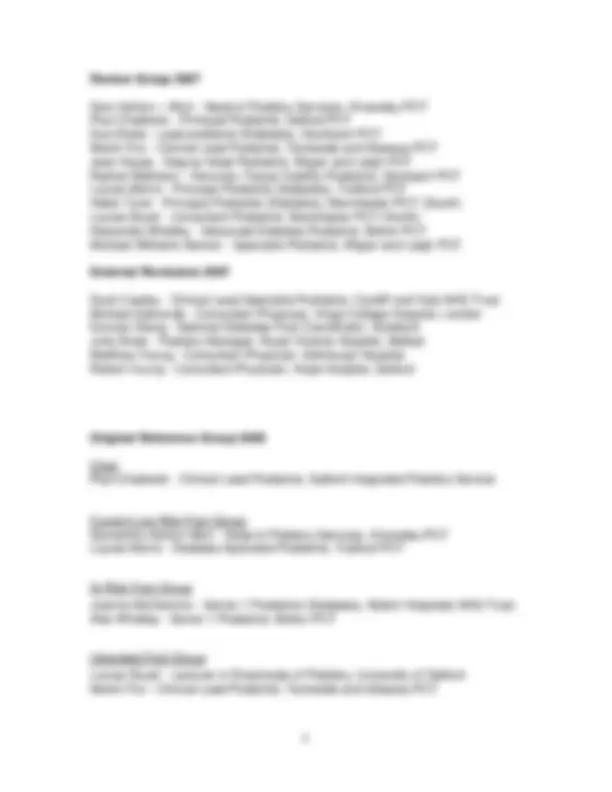

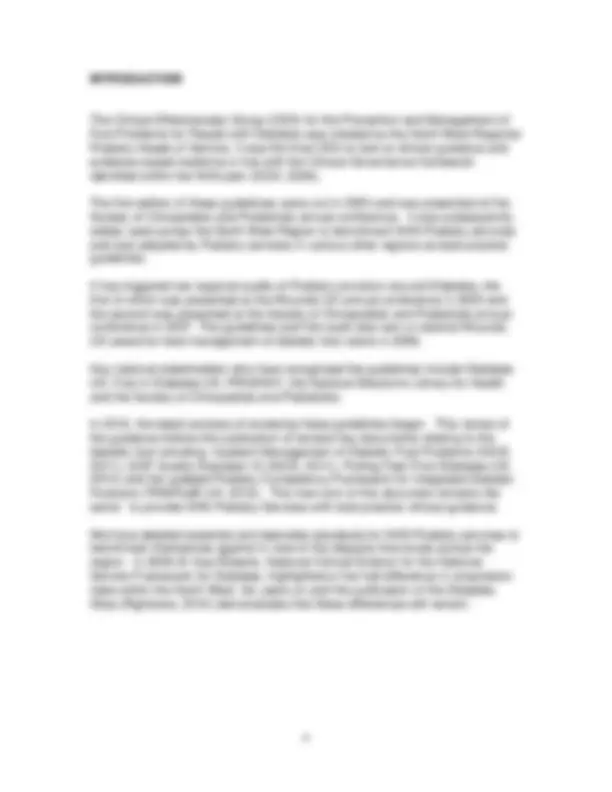
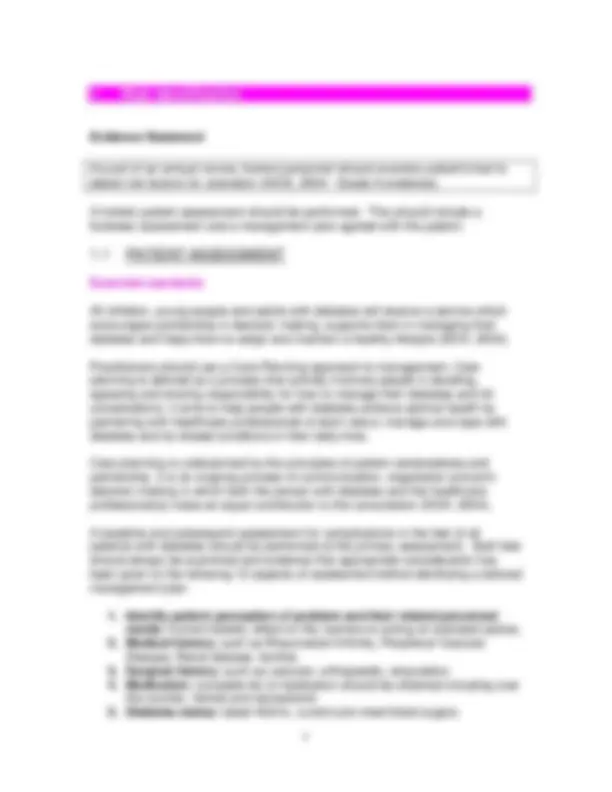

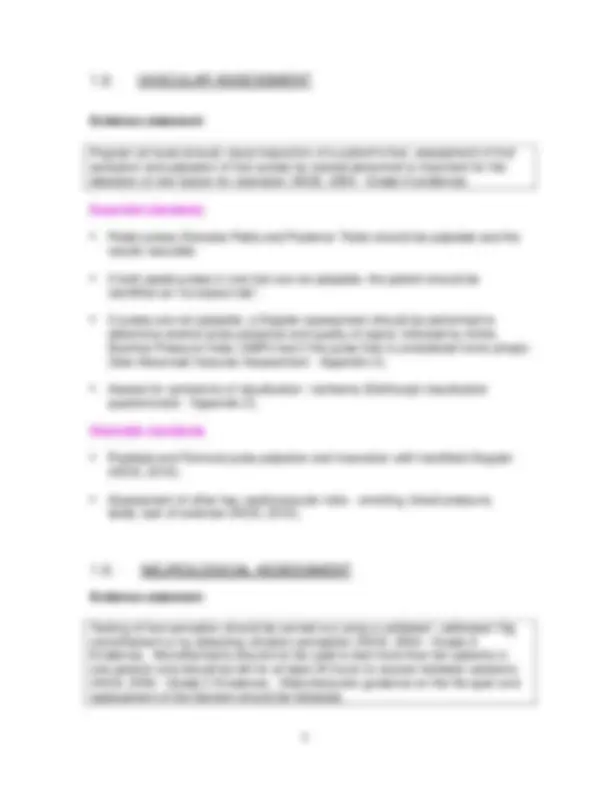
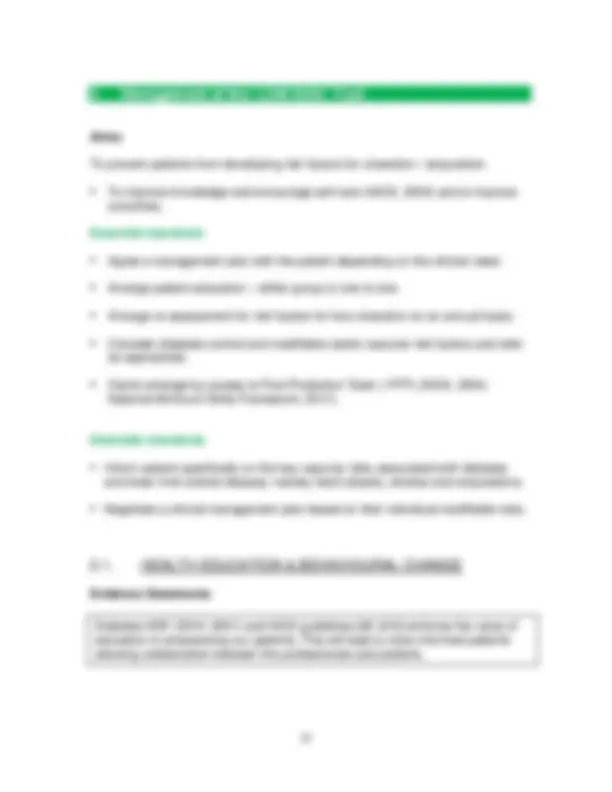
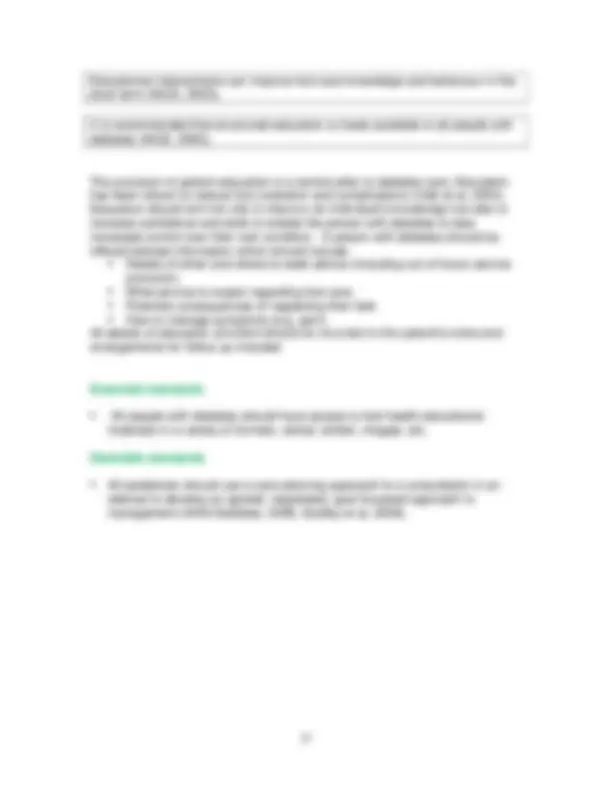
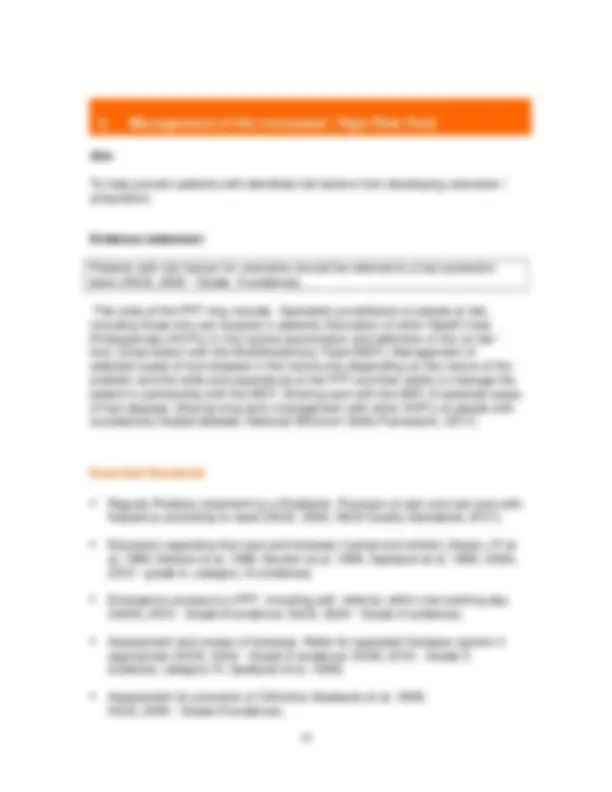
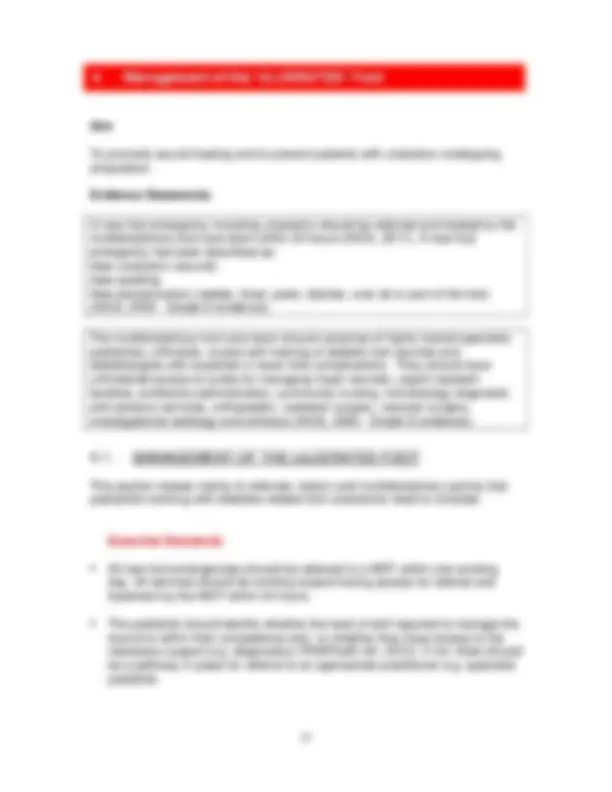
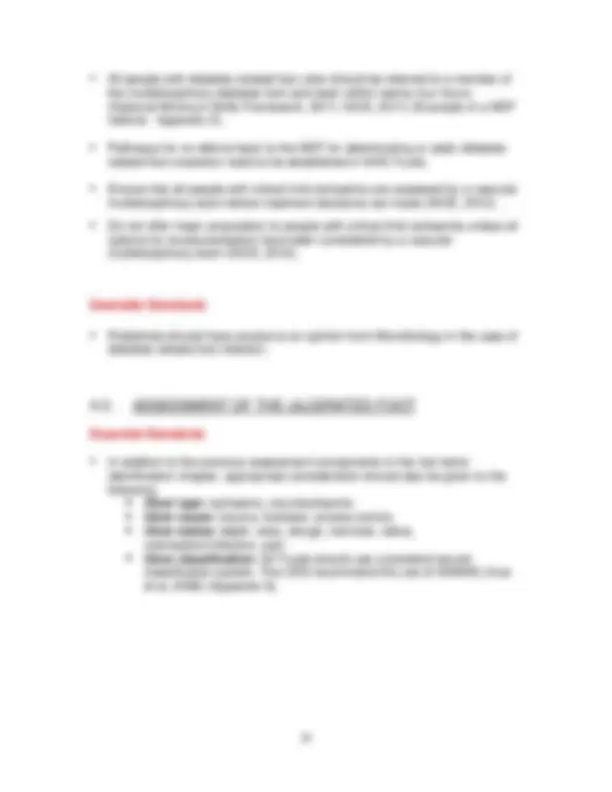
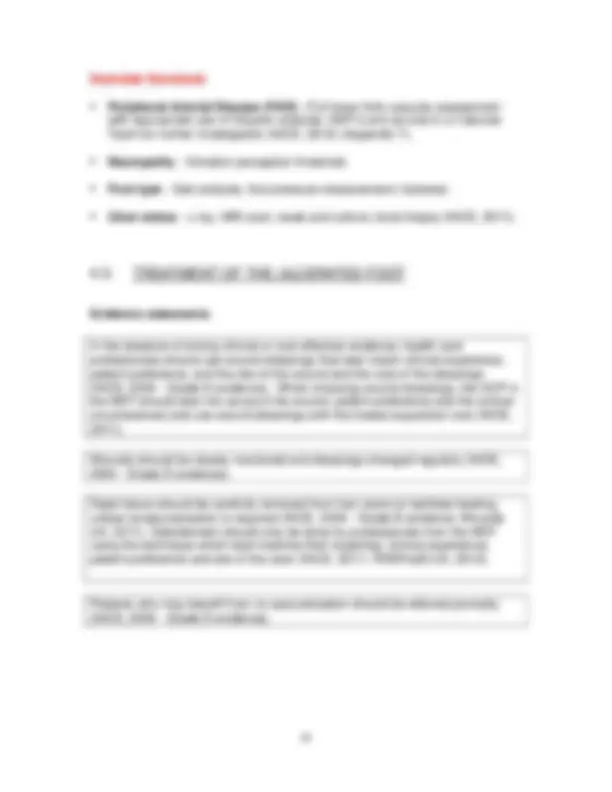
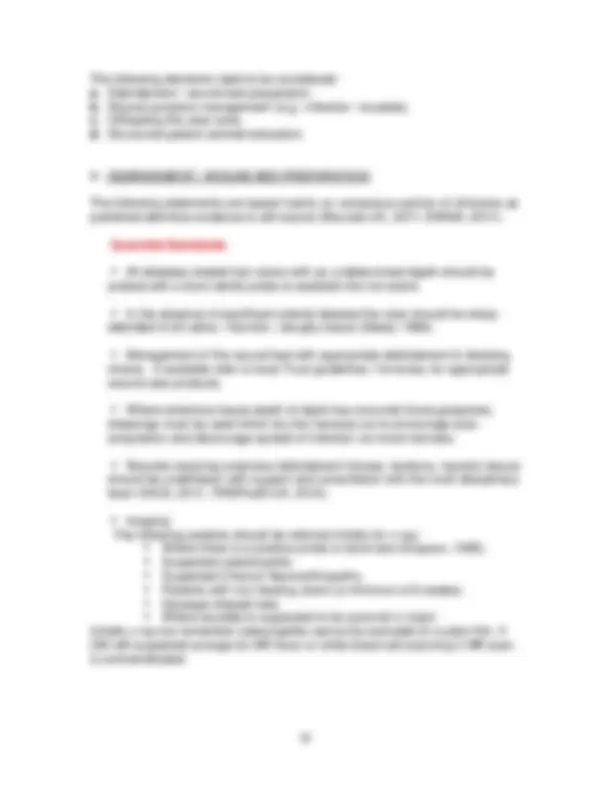
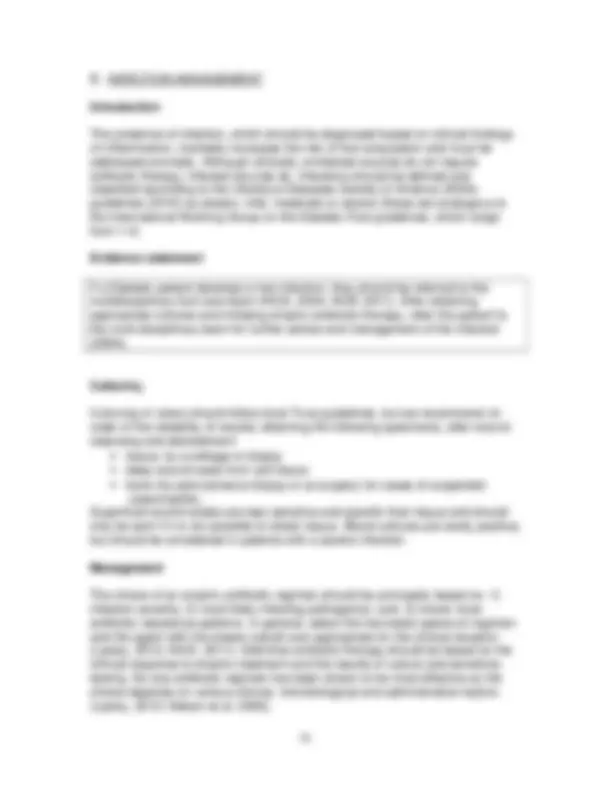
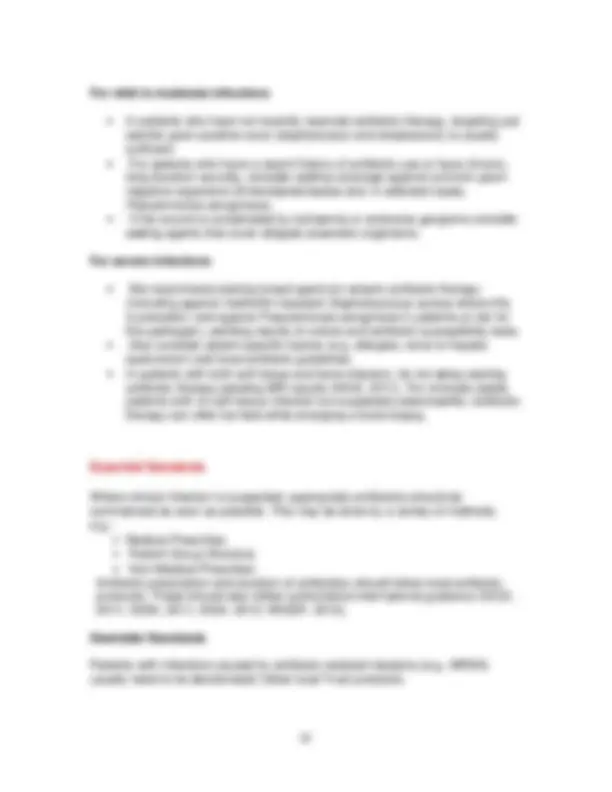
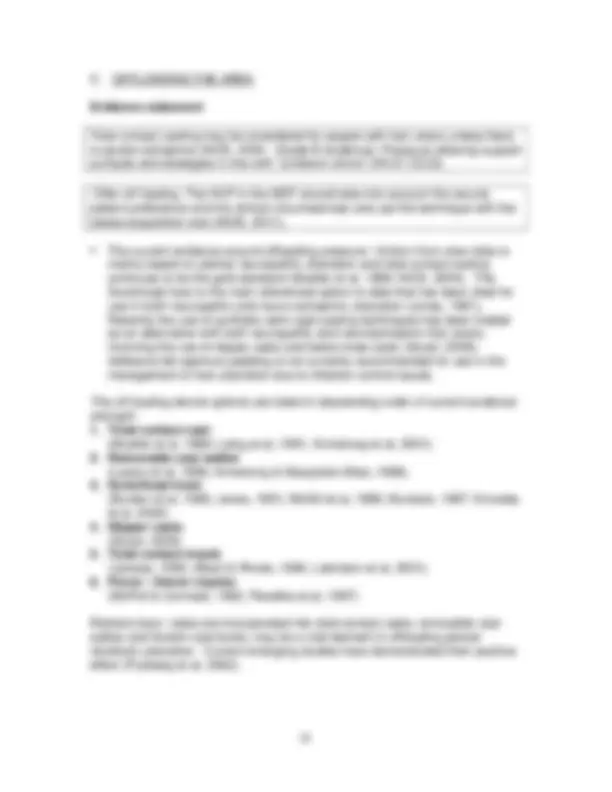
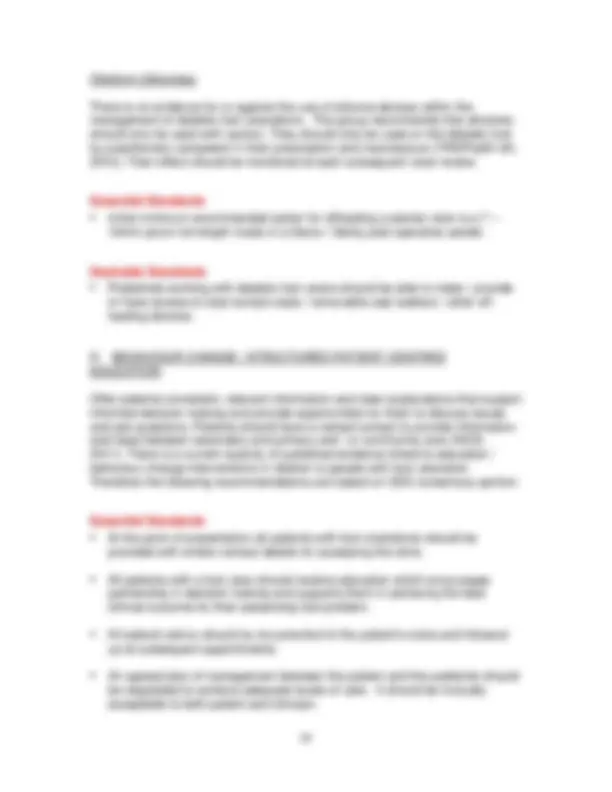

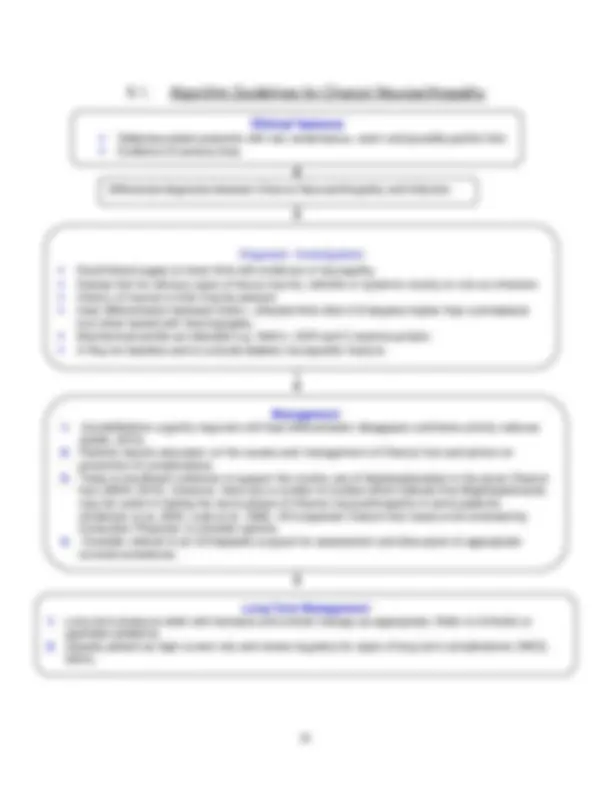
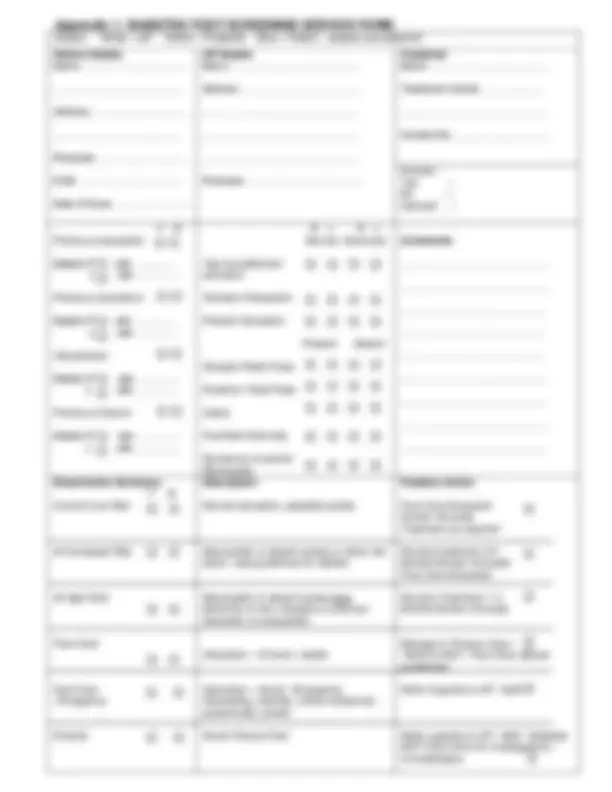
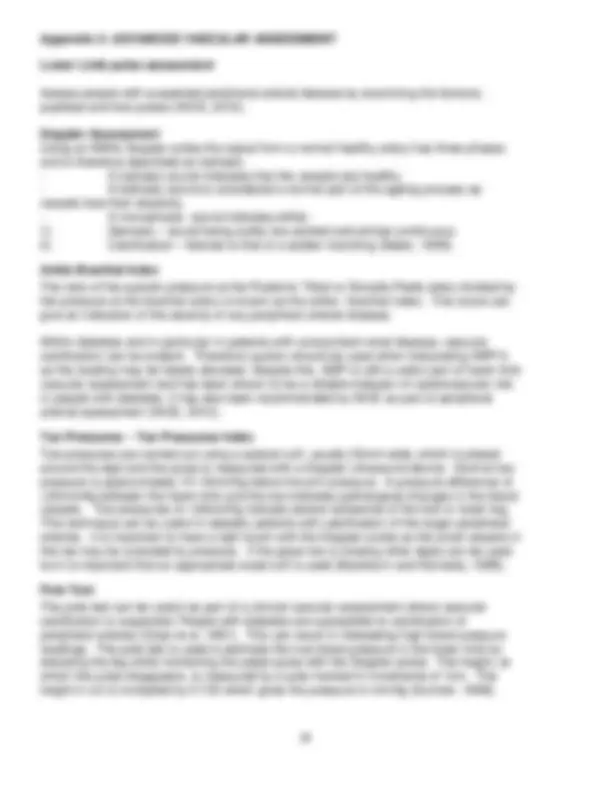
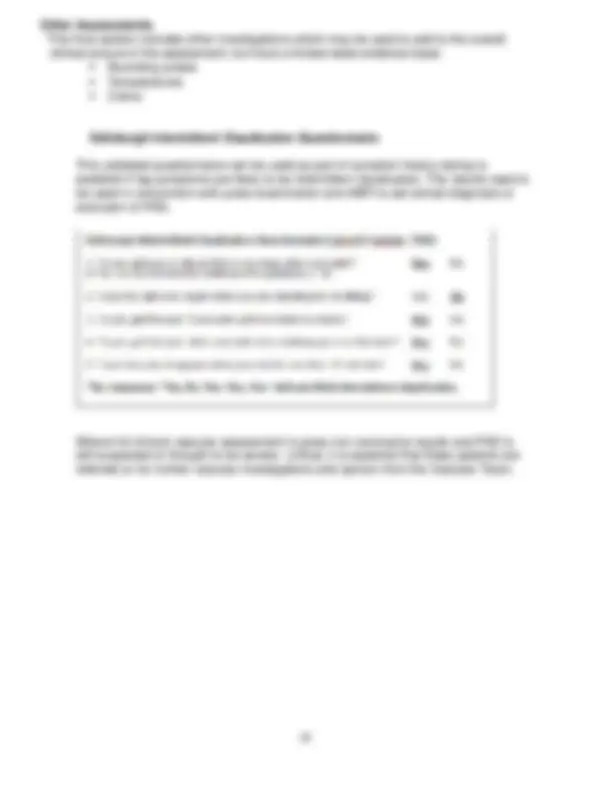
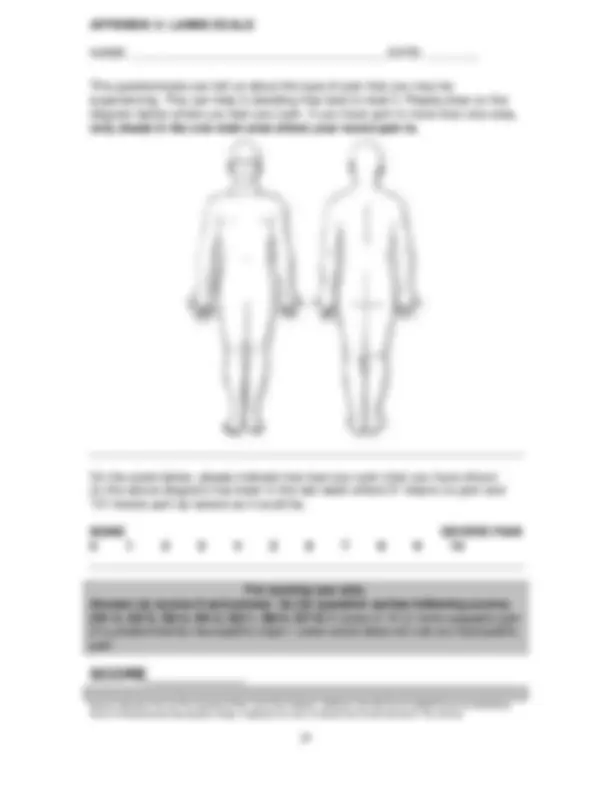

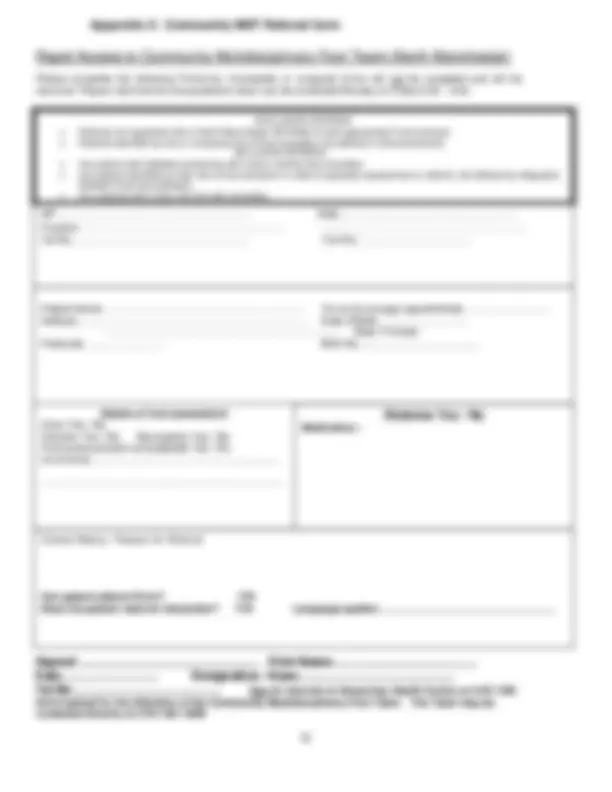
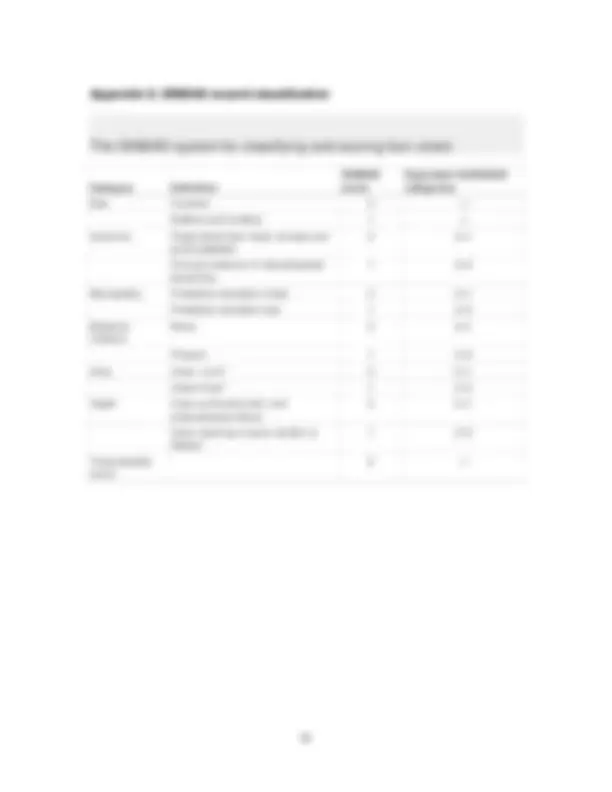
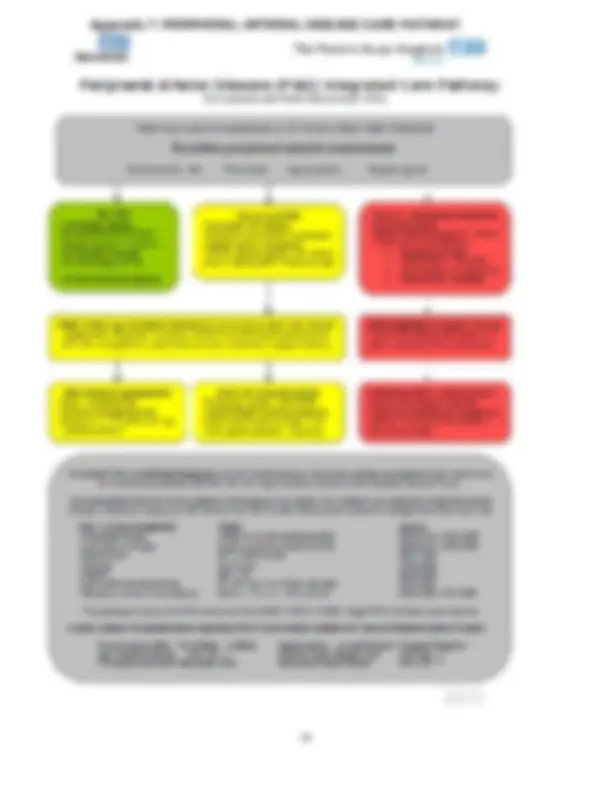
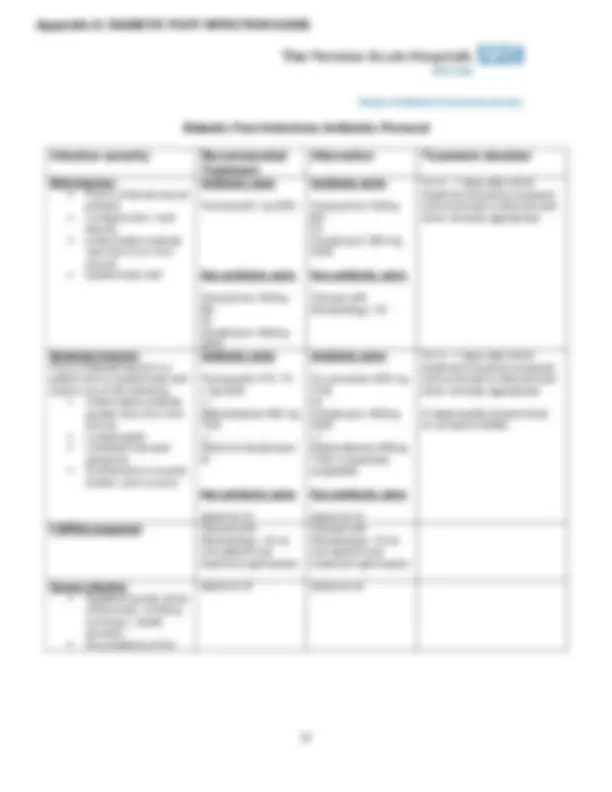
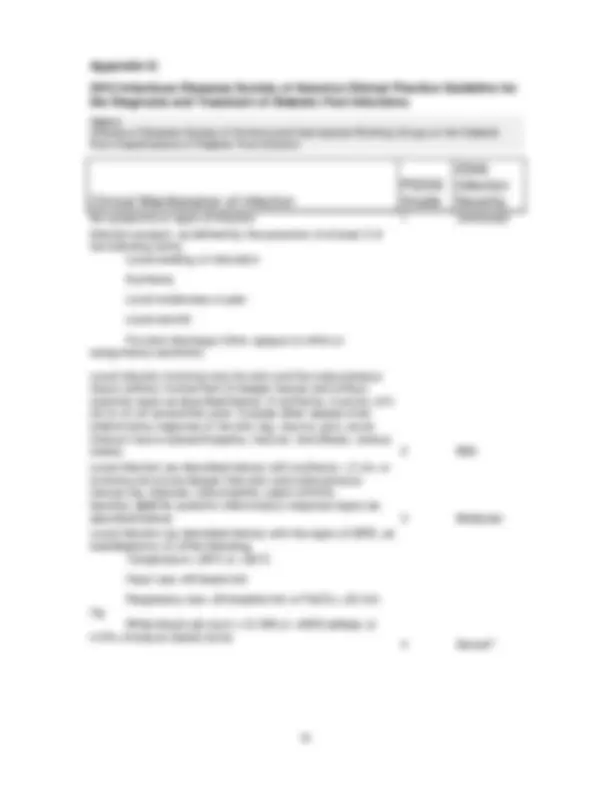
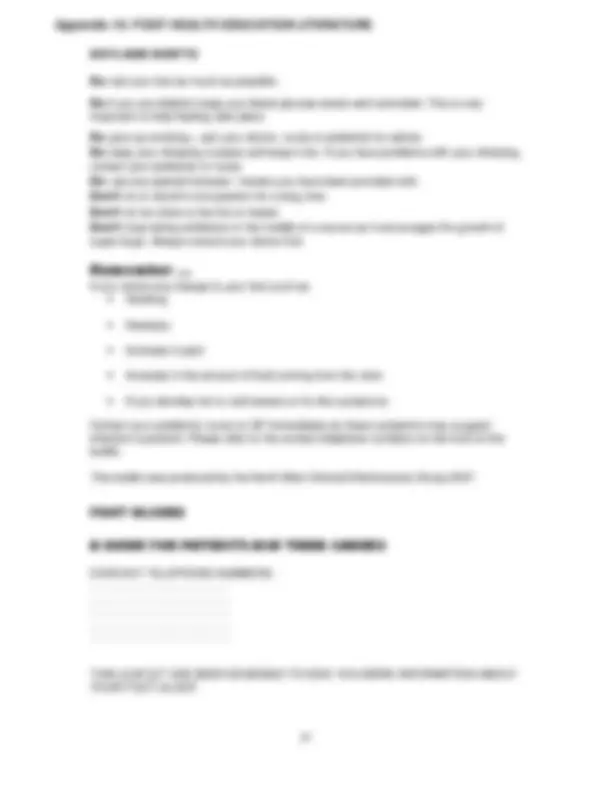
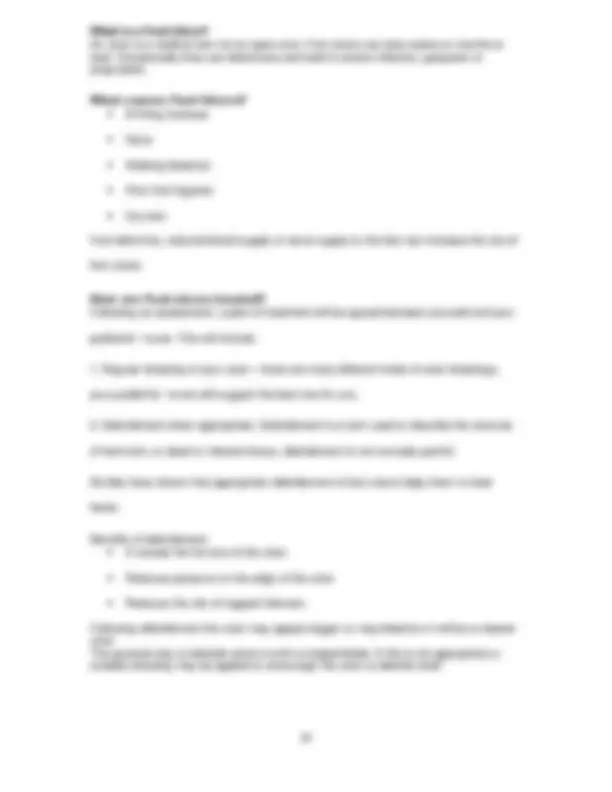
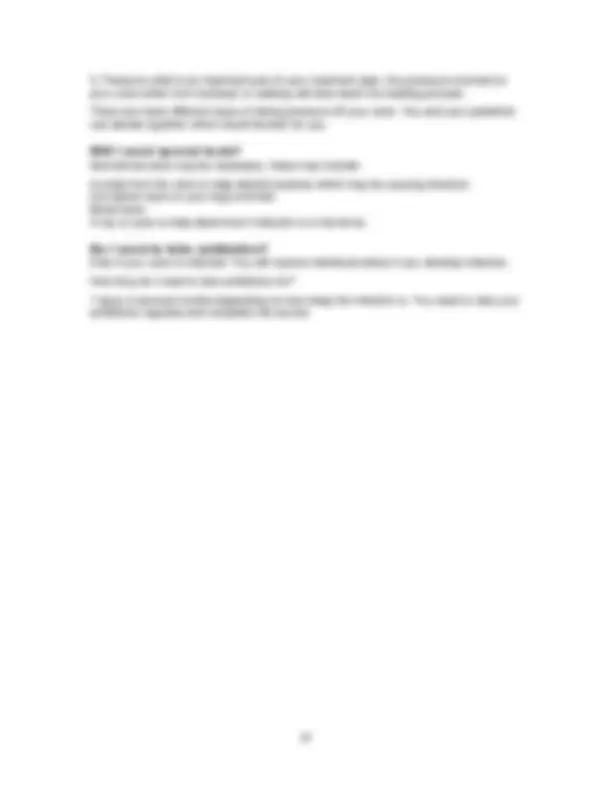

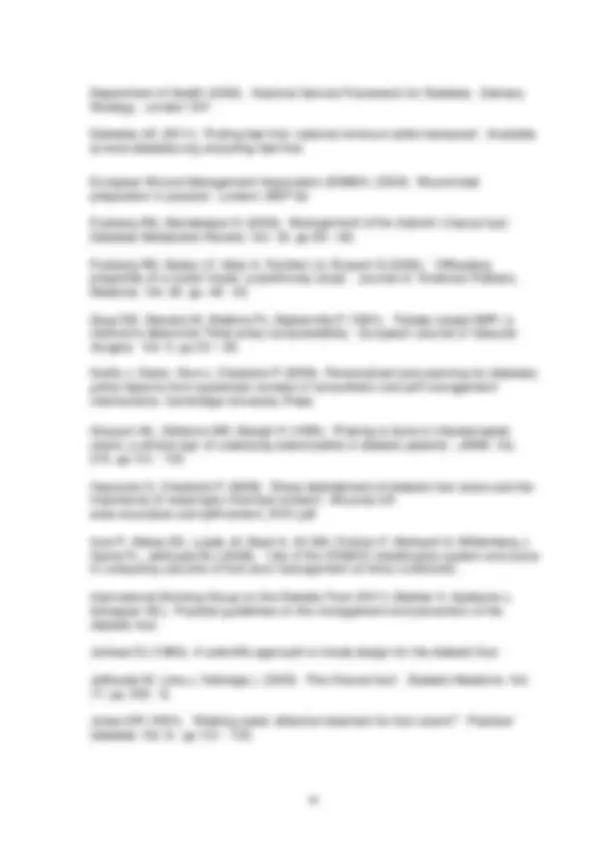

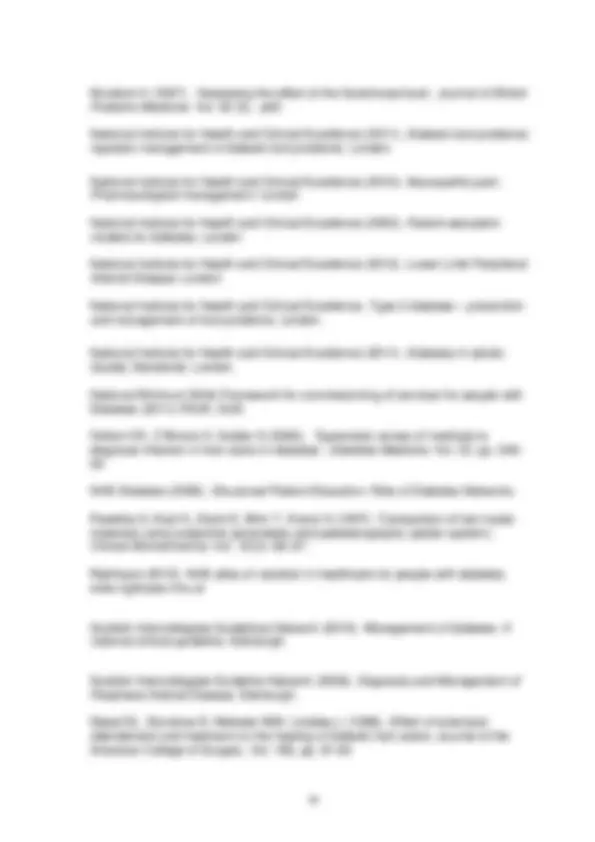



Study with the several resources on Docsity

Earn points by helping other students or get them with a premium plan


Prepare for your exams
Study with the several resources on Docsity

Earn points to download
Earn points by helping other students or get them with a premium plan
Community
Ask the community for help and clear up your study doubts
Discover the best universities in your country according to Docsity users
Free resources
Download our free guides on studying techniques, anxiety management strategies, and thesis advice from Docsity tutors
Guidelines for the prevention and management of foot problems for people with diabetes. The document was developed by the North West Diabetes Foot Care Lead, Mike Edmonds, and Professor Benjamin Lipsky from Oxford University. It includes information on risk factors for foot ulceration, assessment techniques, and recommended interventions. The guidelines have been recognized by the College of Podiatry and have won awards for best diabetic foot ulcer management.
Typology: Study Guides, Projects, Research
1 / 45

This page cannot be seen from the preview
Don't miss anything!






































Date of Issue: July 2014 Date of review of guidelines: December 2016
Review Group 2014
Dr Paul Chadwick - Principal Podiatrist, Salford Royal NHS Foundation Trust Louise Morris - Principal Podiatrist (Diabetes), Trafford PCT Martin Fox - Vascular Specialist Podiatrist, Pennine Acute Hospitals Trust Gaynor Richardson - Clinical Team leader, BTHFC Ceinwen Turner - Liverpool Community Health Sally Andrew - Stockport Foundation Trust Shirley Washington - WWL Kath Jones - Bridgewater Community Trust, Ashton, Leigh and Wigan Jayne Armstrong - Pennine Care (HMR) Leticia Heys - Lancashire Care Foundation Trust Dawn Whitehead - Oldham Community Maria Brockway - Wirral Community Trust Graham Holt - Advanced Practitioner, Pennine Acute Hospitals Trust Helen Tyrer - University Hospitals South Manchester Carolyn Ryder - Pennine Care (HMR) Andrew Sharpe – Team Leader Sefton Andrea Graham - University of Salford PhillIpa Loveday
External Reviewers 2014
Matthew Young - Consultant Physician, Edinburgh Hospital Duncan Stang - National Diabetes Foot Coordinator Scotland Jill Cundell - Lecturer / Practitioner, Northern Ireland Geraint Jones - Consultant Physician, Blackburn. North West Diabetes Foot Care Lead Mike Edmonds – Consultant Physician, King’s College Hospital Benjamin Lipsky – Professor at Oxford University, Division of Medical Sciences
For further information contact: Paul Chadwick Principal Podiatrist Salford Royal NHS Foundation Trust 0161 212 5535 e-mail: paul.j.chadwick@srft.nhs.uk
Contributors
Dr. John Bevans - Specialist Podiatrist, North Manchester General Hospital Mrs M Brockway - Senior 1 Podiatrist, Bebington & West Wirral PCT Ms. Frances Counsell - Chief Podiatrist, Westmorland General Hosp, Kendal Audrey Davies - Podiatrist for Diabetes, Halton PCT Susan Drake - Senior 1 Podiatrist, Southport and Formby PCT Jean Hayes - Deputy Head Podiatrist, Wigan and Leigh PCT Amanda Housley - Diabetes Specialist Podiatrist, Chorley and South Ribble PCT Gillian Lomax - Specialist Podiatrist, Blackburn Hospital Richard Lowe - Senior 1 Podiatrist, Bury PCT Rachel Mathison - Deputy Podiatry Manager, Stockport PCT Estelle Milne - Senior 1 Podiatrist, East Cheshire PCT Susan Popadiuk - Deputy Podiatry Manager, Brookfield Clinic, Preston Denise Prestwich - Clinical Specialist Podiatrist, Devonshire Road, Blackpool Rachel Rowlands - Senior 1 Podiatrist, South Liverpool PCT Michelle Weddell - Senior 1 Podiatrist, Burnley, Pendle & Rossendale NHS PCT Lynne Williams - Senior Diabetes Podiatrist, Warrington PCT Paula Yates - Clinical Specialist Podiatrist, Royal Oldham Hospital
External Reviewers. Prof. P. Wiles - Consultant Diabetologist, North Manchester General Hospital Dr. M. Young - Consultant Diabetologist, Edinburgh Hospital Dr. R. J. Young - Consultant Diabetologist, Hope Hospital, Salford Mr. A McInnes - Lecturer in Podiatry, University of Brighton
Acknowledgements Marie Wilson - Chief Podiatrist, Trafford PCT Victoria Cordwell - SRFT
The Clinical Effectiveness Group (CEG) for the Prevention and Management of Foot Problems for People with Diabetes was initiated by the North West Regional Podiatry Heads of Service. It was the final CEG to look at clinical guidance and evidence based medicine in line with the Clinical Governance framework identified within the NHS plan (DOH, 2004).
The first edition of these guidelines came out in 2004 and was presented at the Society of Chiropodists and Podiatrists annual conference. It was subsequently widely used across the North West Region to benchmark NHS Podiatry services and was adopted by Podiatry services in various other regions as best practice guidelines.
It has triggered two regional audits of Podiatry provision around Diabetes, the first of which was presented at the Wounds UK annual conference in 2005 and the second was presented at the Society of Chiropodists and Podiatrists annual conference in 2007. The guidelines and first audit also won a national Wounds UK award for best management of diabetic foot ulcers in 2006.
Key national stakeholders who have recognised the guidelines include Diabetes UK, Foot in Diabetes UK, PRODIGY, the National Electronic Library for Health and the Society of Chiropodists and Podiatrists.
In 2012, the latest process of reviewing these guidelines began. This review of the guidance follows the publication of several key documents relating to the diabetic foot including: Inpatient Management of Diabetic Foot Problems (NICE, 2011), QOF Quality Standard 10 (NICE, 2011), Putting Feet First (Diabetes UK,
We have detailed essential and desirable standards for NHS Podiatry services to benchmark themselves against in view of the disparity that exists across the region. In 2006 Dr Sue Roberts, National Clinical Director for the National Service Framework for Diabetes, highlighted a five fold difference in amputation rates within the North West. Six years on and the publication of the Diabetes Atlas (Rightcare, 2012) demonstrates that these differences still remain.
1. Risk Identification of Foot Ulceration / Amputation Page 7 1.1. Patient Assessment 1.2. Vascular Assessment - Desirable Standards 1.3. Neurological Assessment - Essential Standards 1.4. Foot Deformity Assessment - Essential Standards 2. Management of the Low Risk Foot. Page 12 2.1. Health education and behaviour change 3. Management of the Increased / High Risk Foot. Page 14 3.1. Additional Standards for Patients with Ischaemia 4. Management of the Ulcerated Foot. Page 17 4.1. Management of the Ulcerated foot 4.2. Assessment of the Ulcerated foot 4.3. Treatment of the Ulcerated foot - 4.4. Wound Documentation 5. Management of Charcot Neuropathy. Page 25
Appendices. Page 27 Appendix 1. Foot Screening tool. Appendix 2. Advance Vascular Assessment. Appendix 3. LANNS Scale Appendix 4. Neuropathy Disability Score Appendix 5. Community MDT referral Appendix 6. TEXAS Foot Ulcer Classification Scale Appendix 7. Peripheral Arterial Disease (PAD) Care Pathway Appendix 8. Diabetic Foot Infection Guidelines Appendix 9. Lipsky Severity Scale Appendix 10. Foot Ulcer Advice Guide
References Page 40
Evidence Statement
As part of an annual review, trained personnel should examine patient’s feet to detect risk factors for ulceration (NICE, 2004 - Grade A evidence).
A holistic patient assessment should be performed. This should include a footwear assessment and a management plan agreed with the patient.
Essential standards
All children, young people and adults with diabetes will receive a service which encourages partnership in decision making, supports them in managing their diabetes and helps them to adopt and maintain a healthy lifestyle (DOH, 2004).
Practitioners should use a Care Planning approach to management. Care planning is defined as a process that actively involves people in deciding, agreeing and sharing responsibility for how to manage their diabetes and its’ complications. It aims to help people with diabetes achieve optimal health by partnering with healthcare professionals to learn about, manage and cope with diabetes and its related conditions in their daily lives.
Care planning is underpinned by the principles of patient-centeredness and partnership. It is an ongoing process of communication, negotiation and joint decision-making in which both the person with diabetes and the healthcare professional(s) make an equal contribution to the consultation (DOH, 2004).
A baseline and subsequent assessment for complications in the feet of all patients with diabetes should be performed at the primary assessment. Both feet should always be examined and evidence that appropriate consideration has been given to the following 12 aspects of assessment before identifying a tailored management plan:
1. Identify patient perception of problem and their related perceived needs: Current beliefs, effect on life, barriers to acting on standard advice. 2. Medical history: such as Rheumatoid Arthritis, Peripheral Vascular Disease, Renal disease, familial. 3. Surgical history: such as vascular, orthopaedic, amputation. 4. Medication: complete list of medication should be obtained including over the counter, herbal and recreational. 5. Diabetes status: latest HbA1c, current pre-meal blood sugars.
Evidence statement
Regular (at least annual) visual inspection of a patient’s feet, assessment of foot sensation and palpation of foot pulses by trained personnel is important for the detection of risk factors for ulceration (NICE, 2004 - Grade A evidence).
Essential standards
Pedal pulses (Dorsalis Pedis and Posterior Tibial) should be palpated and the results recorded.
If both pedal pulses in one foot are not palpable, the patient should be identified as “increased risk”.
If pulses are not palpable, a Doppler assessment should be performed to determine arterial pulse presence and quality of signal, followed by Ankle Brachial Pressure Index (ABPI) test if the pulse flow is considered mono-phasic (See Advanced Vascular Assessment - Appendix 2).
Assess for symptoms of claudication / ischemia (Edinburgh claudication questionnaire - Appendix 2).
Desirable standards
Popliteal and Femoral pulse palpation and insonation with handheld Doppler (NICE, 2012).
Assessment of other key cardiovascular risks - smoking, blood pressure, lipids, lack of exercise (NICE, 2012).
Evidence statement
Testing of foot sensation should be carried out using a validated / calibrated 10g monofilament or by detecting vibration perception (NICE, 2004 - Grade A Evidence). Monofilaments should not be used to test more than ten patients in one session and should be left for at least 24 hours to recover between sessions (NICE, 2004 - Grade C Evidence). (Manufacturers guidance on the life span and replacement of the filament should be followed).
Essential standards
Neuropathy should be identified using a 10g Monofilament and / or 128 MHz tuning fork
The International Working Group on the Diabetic Foot (2011) advised monofilament testing at 3 sites. The sites suggested are under the hallux and the 1st^ and 5th^ metatarsals. The application of the monofilament should be repeated twice at the same site but alternate this with at least one ‘sham’ application in which no filament is applied. Protective sensation is present at each site if patient correctly answers 2 out of 3 applications. Protective sensation is absent with 2 out of 3 incorrect answers and the patient is considered to be at risk of ulceration. In the absence of strong clinical evidence this is the North West Podiatry Services Diabetes CEG recommendation.
The International Working Group on the Diabetic Foot (2011) advised the 128 MHz tuning fork is applied on a bony part on the dorsal side of the distal phalanx of the 1st^ toe. This application should be repeated twice but alternate with at least one ‘sham’ application, in which the tuning fork is not vibrating. The test is positive if the patient correctly answers 2 out of the 3 applications and negative (at risk of ulceration) with 2 out of 3 incorrect answers.
Assessment of painful neuropathic symptoms (LANNS Scale Assessment Tool
Desirable standards
Neurological assessment may also involve the following tests
A neurothesiometer assessment (>25V = reduced perception threshold).
Neuropathy disability score (Appendix 4).
Evidence Statement
Any deformity occurring in a diabetic foot with other risk factors, such as prominence of the metatarsal heads, clawing of the toes, Charcot prominences or hallux valgus, increases ulcer risk (Abbott et al, 2002).
Aims:
To prevent patients from developing risk factors for ulceration / amputation.
To improve knowledge and encourage self care (NICE, 2004) and to improve outcomes.
Essential standards
Agree a management plan with the patient depending on the clinical need.
Arrange patient education – either group or one to one.
Arrange re-assessment for risk factors for foot ulceration on an annual basis.
Consider diabetes control and modifiable cardio-vascular risk factors and refer as appropriate.
Clarify emergency access to Foot Protection Team ( FPT) (NICE, 2004; National Minimum Skills Framework, 2011).
Desirable standards
Inform patient specifically on the key vascular risks associated with diabetes and lower limb arterial disease, namely heart attacks, strokes and amputations.
Negotiate a clinical management plan based on their individual modifiable risks.
Evidence Statements
.
EDUCATION
Diabetes NSF (DOH, 2001) and NICE guidelines [60 &10] reinforce the value of education in empowering our patients. This will lead to more informed patients allowing collaboration between the professionals and patients.
Educational interventions can improve foot care knowledge and behaviour in the short term (NICE, 2003).
It is recommended that structured education is made available to all people with diabetes (NICE, 2003).
The provision of patient education is a central pillar to diabetes care. Education has been shown to reduce foot ulceration and complications (Valk et al, 2004). Education should aim not only to improve an individual’s knowledge but also to increase confidence and skills to enable the person with diabetes to take increased control over their own condition. A person with diabetes should be offered tailored information which should include: Details of when and where to seek advice (Including out of hours service provision). What service to expect regarding foot care. Potential consequences of neglecting their feet. How to manage symptoms (e.g. pain). All details of education provided should be recorded in the patient’s notes and arrangements for follow up included.
Essential standards
All people with diabetes should have access to foot health educational materials in a variety of formats, verbal, written, images, etc.
Desirable standards
All podiatrists should use a care planning approach to a consultation in an attempt to develop an agreed, negotiated, goal focussed approach to management (NHS Diabetes, 2006; Graffey et al, 2009).
Referral for assessment of control of diabetes (SIGN, 2010 - Grade A evidence, Category 1b).
Assessment and referral regarding other lifestyle changes including smoking, alcohol intake, exercise, weight loss (Moss et al, 1992; Beach et al, 1980; SIGN, 2010 - Grade B, Category III evidence).
Referral for assessment and appropriate treatment of neuropathic pain including optimising glycaemic control and neuropathic analgesics, in line with NICE (2010) Neuropathic pain: pharmacological management (CG96). Painful neuropathy can be assessed using the LANNS scale, (Appendix 3).
Desirable Standards
All podiatrists should use a care planning approach to a consultation in an attempt to develop an agreed, negotiated, goal focussed approach to management (NHS Diabetes, 2006; Graffey et al, 2009).
Ensure patient has had a diabetes annual review.
Inform patient specifically on the key vascular risks associated with diabetes and lower limb arterial disease, namely heart attacks, strokes and amputation.
Negotiate a clinical management plan based on their individual modifiable risks.
Essential standards
Refer for full, non invasive vascular assessment of the lower limb for all people with suspected peripheral arterial disease (PAD), whether asymptomatic, or with symptoms suggestive of intermittent claudication or ischaemic rest pain (NICE, 2012. Appendix 2)
On diagnosis of PAD, consider the need to refer for optimal medical management of cardio vascular risk factors i.e. hypertension, anti-platelet therapy and lipid lowering drugs (NICE, 2012).
Make all people with PAD aware of smoking cessation strategies (Moss et al, 1992; SIGN, 2010 - Grade B, level III evidence). Nicotine replacement therapy has been beneficial and has been proven to positively influence patients motivated to stop smoking. Smoking is known to contribute to peripheral vascular disease (SIGN, 2006).
Provide education regarding lifestyle changes including walking exercise, and alcohol intake or weight loss where appropriate (NICE, 2012).
Desirable Standards
Provide full non invasive vascular assessment of the lower limb (NICE, 2012), where podiatrists with such skills are available (Appendix 2).
Ensure rapid access to vascular specialist team is available, especially for people with suspected critical limb ischaemia (NICE, 2012).
For people with intermittent claudication, educate about, promote and refer to supervised exercise programmes where available. Promote walking and cardiovascular exercise generally. Exercise regimes are beneficial for patients with intermittent claudication and walking distances can be improved (NICE, 2012; SIGN, 2006).
All people with diabetes related foot ulcer should be referred to a member of the multidisciplinary diabetes foot care team within twenty four hours (National Minimum Skills Framework, 2011; NICE, 2011) (Example of a MDT referral - Appendix 5).
Pathways for re-referral back to the MDT for deteriorating or static diabetes related foot ulceration need to be established in NHS Trusts.
Ensure that all people with critical limb ischaemia are assessed by a vascular multidisciplinary team before treatment decisions are made (NICE, 2012).
Do not offer major amputation to people with critical limb ischaemia unless all options for revascularisation have been considered by a vascular multidisciplinary team (NICE, 2012).
Desirable Standards
Podiatrists should have access to an opinion from Microbiology in the case of diabetes related foot infection.
Essential Standards
In addition to the previous assessment components in the risk factor identification chapter, appropriate consideration should also be given to the following: Ulcer type: ischaemic, neuroischaemic Ulcer cause: trauma, footwear, excess activity Ulcer status: depth, area, slough, necrosis, callus, colonisation/infection, pain. Ulcer classification: All Trusts should use a standard wound classification system. The CEG recommend the use of SINBAD (Ince et al, 2008) (Appendix 6).
Desirable Standards
Peripheral Arterial Disease (PAD) - Full lower limb vascular assessment with appropriate use of Doppler analysis, ABPI’s and access to a Vascular Team for further investigation (NICE, 2012) (Appendix 7).
Neuropathy - Vibration perception threshold.
Foot type - Gait analysis, foot pressure measurement, footwear.
Ulcer status - x-ray, MRI scan, swab and culture, bone biopsy (NICE, 2011).
Evidence statements
In the absence of strong clinical or cost effective evidence, health care professionals should use wound dressings that best match clinical experience, patient preference, and the site of the wound and the cost of the dressings (NICE, 2004 - Grade D evidence). When choosing wound dressings, the HCP in the MDT should take into account the wound, patient preference and the clinical circumstances and use wound dressings with the lowest acquisition cost (NICE, 2011).
Wounds should be closely monitored and dressings changed regularly (NICE, 2004 - Grade D evidence).
Dead tissue should be carefully removed from foot ulcers to facilitate healing, unless revascularisation is required (NICE, 2004 - Grade B evidence; Wounds UK, 2011). Debridement should only be done by professionals from the MDT using the technique which best matches their expertise, clinical experience, patient preference and site of the ulcer (NICE, 2011; TRIEPodD-UK, 2012).
Patients who may benefit from re-vascularisation should be referred promptly (NICE, 2004 - Grade D evidence).